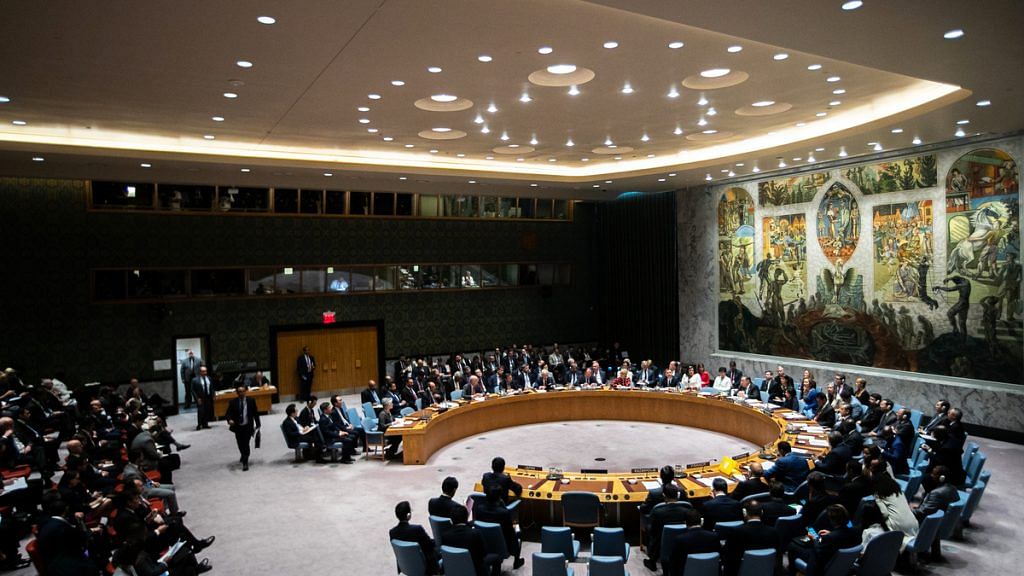New Delhi: India was elected as a non-permanent member of the United Nations Security Council (UNSC) for a two-year term Wednesday, with an overwhelming majority. It garnered 184 votes in the General Assembly that consists of 193 members.
Prime Minister Narendra Modi also said he was “deeply grateful” for the support of the global community towards the security council membership.
Deeply grateful for the overwhelming support shown by the global community for India's membership of the @UN Security Council. India will work with all member countries to promote global peace, security, resilience and equity.
— Narendra Modi (@narendramodi) June 18, 2020
The two-year term will begin on 1 January 2021, and along with India — Ireland, Mexico and Norway were also elected to the council.
India was the sole candidate from the Asia-Pacific region vying for a non-permanent membership. Its candidature was unanimously endorsed by the 55-member Asia-Pacific Group in June last year.
This is the eighth time India has been elected a non-permanent member of the UNSC. Previously, it has been elected as a member for the period of 1950-1951, 1967-1968, 1972-1973, 1977-1978, 1984-1985, 1991-1992 and 2011-2012.
ThePrint looks into what exactly the United Nations Security Council is and how a country is elected as a member.
Also read: Nearly 49 million more people vulnerable to extreme poverty because of Covid-19: UN Chief
UN Security Council
The UN Security Council is one of the six main organs of the UN, and is primarily responsible for maintaining international peace and security.
The other five organs of the UN are the General Assembly, the Economic and Social Council, the Trusteeship Council, the International Court of Justice and the Secretariat.
The UNSC held its first session on 17 January 1946 in Westminster, London. Since then, the main headquarters for the council has been in New York City at the UN Headquarters.
It consists of 15 members — five permanent members and 10 non-permanent members. The five permanent members are the US, UK, Russia, China and France. Every year, five non-permanent members are elected for a tenure of two years.
For a long time, India has pushed to be considered for permanent membership in the council. It has also been backed by several countries in this regard, including US President Donald Trump.
To be elected as a non-permanent member of the council, each member-country requires a two-third majority of the entire assembly.
At the eighteenth session of the UNSC in 1963, the General Assembly had decided that the non-permanent members of the council should be elected according to the following pattern: Five members from African and Asian countries, one from Eastern Europe, two Latin American countries and two from Western Europe and other countries.
The current non-permanent members are Belgium, Dominican Republic, Estonia, Germany, Indonesia, Niger, Saint Vincent and the Grenadines, South Africa and Tunisia.
Also read: Schools re-opening during crisis not a return to normal, we must do things differently: UN
Responsibilities and powers of the UNSC
If there is a security crisis anywhere in the world, the matter is brought before the UNSC and they try to reach an agreement either through mediation, appointing special envoys, dispatching a UN Mission or requesting the UN Secretary-General to settle the dispute.
If the matter escalates, ceasefire directives are issued and peacekeeping forces and military observers dispatched.
Furthermore, if the circumstances are very dire then sanctions and financial penalties are imposed, arms embargoed, and travel bans can also be issued.
Also read: Paris deal to WHO, the 11 organisations Donald Trump’s US has pulled out of, weakened
Powers of permanent and non-permanent members
The permanent members of the UNSC have a veto power. This veto allows any of these five countries to block the adoption of a resolution. However, they cannot end or prevent a debate through this power.
Until 2012, as many as 269 vetoes had been used in the UNSC. China used it nine times, it was used 18 times by France, 32 times by UK, 83 times by US and 128 times by Russia (and USSR).
Unlike permanent members of the council, the non-permanent members do not have veto power. However, they have “collective right of veto” — any resolution of the UNSC has to be passed by at least seven non-permanent members even if all the permanent members support it.
Every member-country of the council, including the non-permanent members, also assumes the presidency of the council every month. The presidency is determined in an alphabetical order.
This allows them to decide the content and theme of the debates, which can draw attention to important issues for each member country with respect to international peace and security.
The current president of the council is France for June 2020.
Also read: UN official raises concerns over hate speech in India, cites Subramanian Swamy’s comments
Committees of the UN Security Council
The non-permanent members also preside over committees and working groups of the UNSC.
The subsidiary bodies of the council are known as committees — Counter-Terrorism Committee, Non-Proliferation Committee, United Nations Military Staff Committee and Sanctions Committee.
The council uses sanctions to put pressure on a country to comply with its objectives, without using force.
The UNSC has used sanctions when peace has been threatened and diplomatic efforts failed.
Sanctions include economic and trade sanctions along with diplomatic restrictions and travel bans. Currently, there are 14 ongoing sanction regimes in the world that focus on settlement of political conflicts, nuclear non-proliferation and counter-terrorism.
